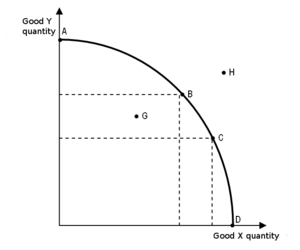Production capacity curve
| Production capacity curve |
|---|
| See also |
Production capacity curve presents graphically the maximum possible production of one good, given the size of the production of another good. The curve shows the various combinations of the quantities of goods or services which are possible to manufacture, where all available resources are fully used.
Production capacity curve plot
Graphical representation of the capacity curve may take the form of a straight or convex line.
Linear capacity plot
Shows quantity of goods, which company has to give up in exchange for a production of number of other good.
Convex capacity plot
Indicates that increasing production of one good, company has to give up more second good (or reducing the production of a particular good it get in return, produce ever larger amounts of other good). Concave of curve in relation to the origin of the coordinate system is a consequence of the law of diminishing returns. Moving on the curve from point A to B, B to C, C to D, we get decreasing numbers of good X, along greater production of good Y.
|
Convex production capacity plot |

Linear production capacity plot |
Analysis of plots
Production capacity curve separates from each other two sets: a combination of goods that are inefficient, but available (under the curve) and impossible combinations of goods (over the curve). The position at the point G, it's a situation where we do not use all the resources at our disposal at any given time. The combination at the point H is reached at the given level of resources, knowledge and technology. The H point may be achieved over a longer period of time as a result of technical progress. Points on the capacity curve (e.g. B, C) shows a situation where the available resources are used fully effectively. The transition from point A to B, B what C, etc. means the moving of productive resources (e.g. machines, manpower) from production of good Y to the production of good X.
Capacity curve is also called transformation curve, due to the fact that moving production and resources from one good to another is a kind of transformation of one good to another.
References
- Kleindorfer, P. R., Singhal, K., & Wassenhove, L. N. (2005). Sustainable operations management. Production and operations management, 14(4), 482-492.
